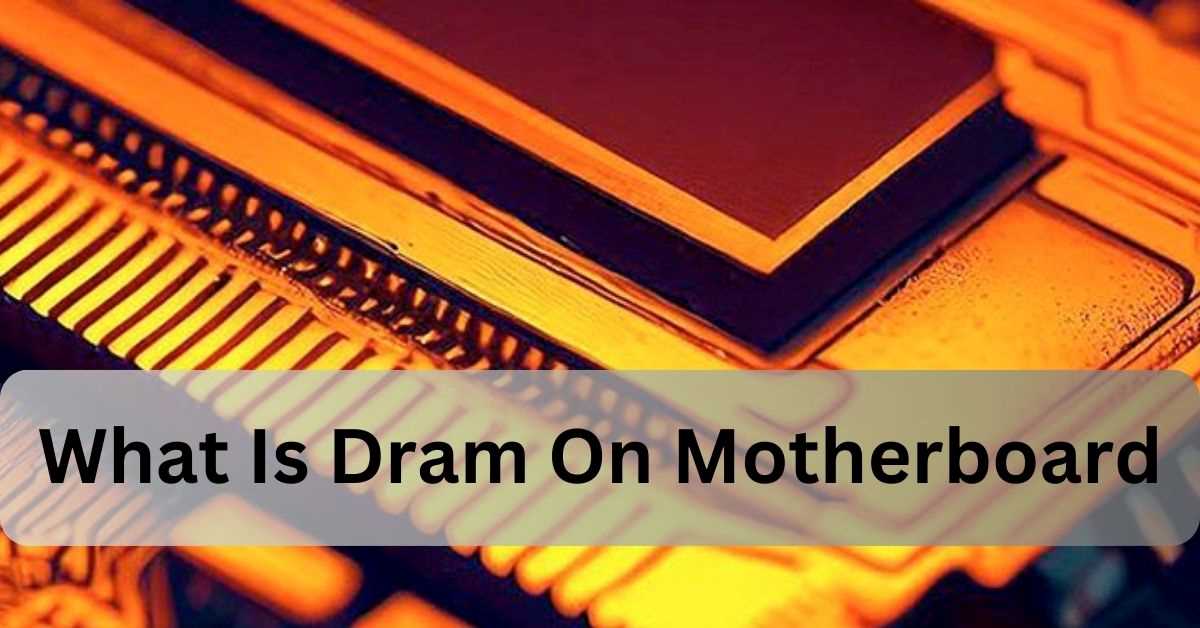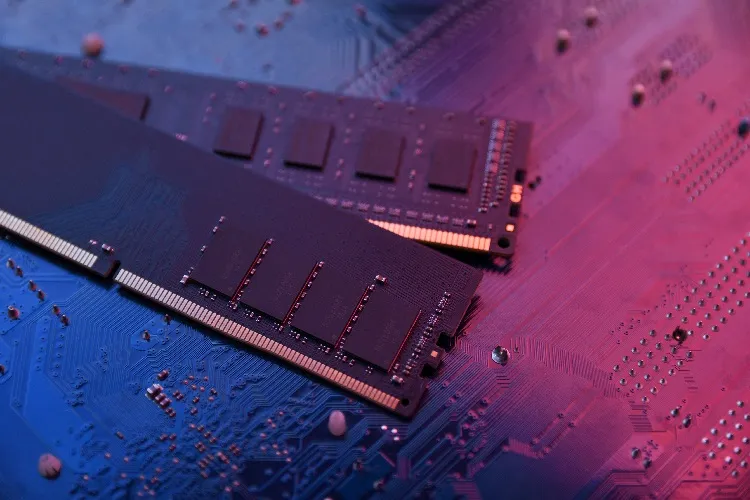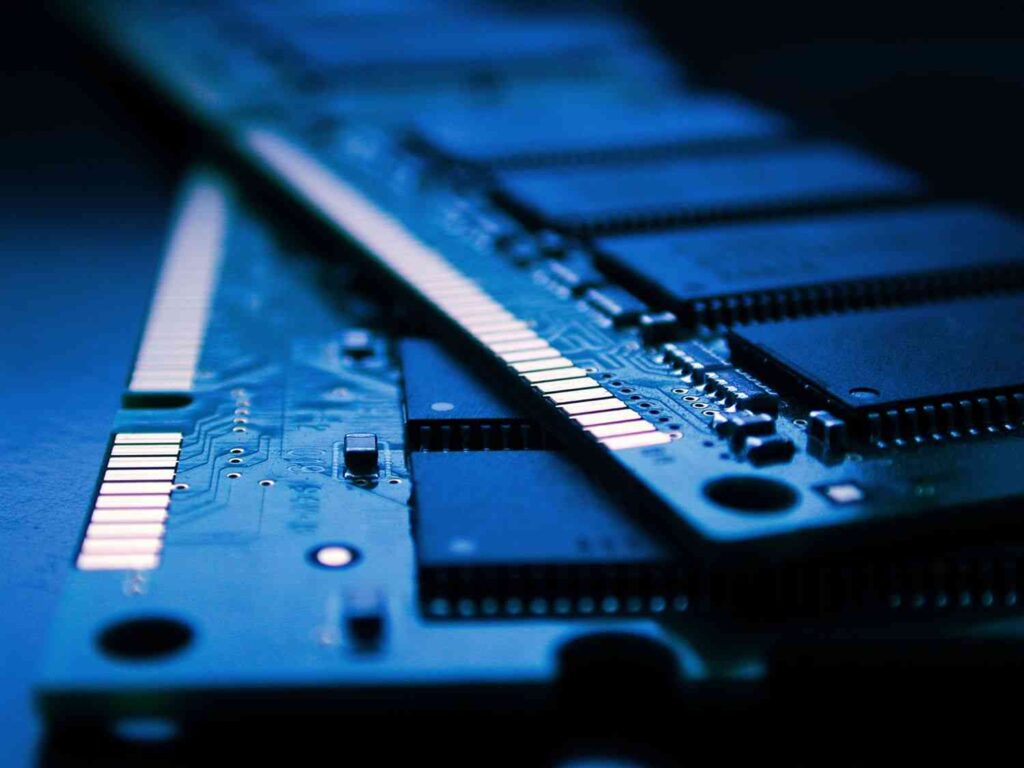
What Is Dram On Motherboard, DRAM (Dynamic Random Access Memory) on a motherboard temporarily holds data for the CPU to access quickly. It helps your computer run smoothly by letting the CPU get to any data it needs fast. Properly installing and checking compatibility is key for it to work well.
When I built my first PC, the orange DRAM light on the motherboard indicated a memory issue. After reseating the RAM and ensuring compatibility, my PC booted smoothly, highlighting DRAM’s role in allowing the CPU quick data access.
Learn what DRAM (Dynamic Random Access Memory) is and how it works on a motherboard. Find out how DRAM helps your computer by storing data for the CPU to access quickly, making your system run smoothly.
What Does Dram On A Motherboard Do?
DRAM (Dynamic Random Access Memory) on a motherboard is crucial for your computer. It temporarily holds data that the CPU (Central Processing Unit) needs right away, like information from open programs and tasks. Since DRAM is volatile, it loses data when the computer is turned off, unlike long-term storage devices like SSDs or HDDs.
DRAM helps the CPU access data quickly, which keeps your computer running smoothly. It needs regular refreshing to keep data from disappearing, unlike SRAM (Static RAM) that doesn’t need this. Having more DRAM allows your computer to handle more tasks at once and run faster, improving overall performance.
How Does Dram Affect Computer Performance?
Speed of Data Access:
DRAM helps your computer quickly access data that the CPU needs. This means programs run faster and multitasking is smoother because the computer doesn’t have to wait for slower storage drives.
System Responsiveness:
Having enough DRAM allows your computer to run more programs at once without slowing down. This makes everything feel more responsive, even when you’re using multiple applications.
Performance Impact:
The amount and speed of DRAM can affect how well your computer performs. More DRAM lets you handle larger files and more demanding programs, while faster DRAM speeds up data access and processing.
Load Times:
DRAM helps reduce how long it takes for programs and the operating system to start. By quickly providing data to the CPU, DRAM makes booting up and launching applications faster.
Multitasking Efficiency:
With enough DRAM, your computer can manage multiple tasks at the same time more efficiently. This is useful when running several programs or working with big files, as it keeps the system running smoothly.
Gaming and Graphics:
For gaming and graphic-heavy tasks, DRAM is crucial. It helps load game graphics and other assets quickly, making gameplay smoother and graphics better.
Why Is Dram Important For A Motherboard?
DRAM (Dynamic Random Access Memory) is crucial for your computer because it helps it run smoothly and quickly. It temporarily stores data that the CPU needs right away, which is much faster than getting it from hard drives or SSDs. This speed helps the CPU work efficiently and handle multiple tasks at once.

DRAM also helps your computer multitask by keeping active programs and data readily available, so you can run several applications without slowing down. For activities like gaming or video editing, DRAM ensures your computer remains responsive and performs well. Without enough DRAM, your computer might become slow or unresponsive.
Read: Why Is The Motherboard Useful? – Boost Your Pc Performance!
When Should You Check Dram On Your Motherboard?
- PC Fails to Boot: If your computer won’t start or shows error messages, check the DRAM. An orange or red DRAM light often means there’s a problem with the RAM.
- System Crashes or Freezes: Frequent crashes, freezes, or blue screens might be caused by faulty or loose DRAM. Inspect the RAM if these issues occur.
- Performance Issues: If your computer is running slowly, checking the DRAM can help find out if the memory is causing the problem. Make sure the RAM is properly installed and working.
- Upgrading or Installing New Components: When adding new hardware, like a new motherboard or RAM, check the DRAM to make sure it’s correctly installed and compatible.
- Error Codes or Beep Sounds: Some motherboards give error codes or beeping sounds for memory problems. Consult your motherboard manual and check the DRAM if you hear these signals.
- After Cleaning or Moving the Computer: If you’ve recently cleaned or moved your computer, check the DRAM to ensure it’s still securely in place.
How Is Dram Installed On A Motherboard?
1. Identify the RAM Slots:
On the motherboard, locate the RAM slots, which are usually long, narrow slots positioned near the CPU socket. They are often color-coded to indicate which slots should be used for optimal performance.
2. Prepare the RAM Modules:
Ensure you have the correct type of DRAM (e.g., DDR4, DDR5) that is compatible with your motherboard. Remove any packaging from the RAM modules.
3. Align the RAM Module:
Each RAM module has a notch that aligns with a key in the RAM slot. This ensures it can only be inserted in one direction. Adjust the score on the Smash module with the vital in the opening.
4. Insert the RAM Module:
Delicately push down on the Smash module until it fits properly. You should hear a click as the clips on either side of the slot snap into position, holding the RAM securely.
5. Ensure Proper Seating:
Check that the RAM is fully seated and level in the slot. The clips on the sides should be firmly engaged with the notches on the RAM module.
6. Verify Installation:
Double-check the motherboard manual to confirm that the RAM modules are installed in the correct slots for dual-channel or multi-channel configurations, if applicable.
7. Power On and Test:
Power on your computer and enter the BIOS/UEFI settings to ensure that the system recognizes the newly installed RAM. You can also check the system’s properties in the operating system to verify that the RAM is detected and functioning correctly.
8. Troubleshoot if Necessary:
If the system does not boot or if the RAM is not recognized, recheck the installation. Ensure that the modules are properly seated and that there is no dust or debris in the slots.
By following these steps, you can properly install DRAM on your motherboard and ensure your computer runs smoothly with the new memory.
What Types Of Dram Are Used In Motherboards?
1. SDRAM (Synchronous DRAM):
- Description: Synchronizes with the system clock, allowing it to handle data more efficiently by aligning its operations with the CPU’s timing.
- Usage: Commonly used in older and some current motherboards to improve speed and performance compared to earlier DRAM types.
2. DDR SDRAM (Double Data Rate SDRAM):
- Description: Transfers data twice per clock cycle (on both the rising and falling edges of the clock signal), effectively doubling the data rate of traditional SDRAM.
- Variants: Includes DDR, DDR2, DDR3, DDR4, and DDR5. Each new generation offers improved speed, efficiency, and capacity:
- DDR2: Enhanced performance over DDR with lower power consumption and higher data rates.
- DDR3: Further improvements in speed and power efficiency compared to DDR2.
- DDR4: Offers even higher speeds and better energy efficiency, now common in most modern motherboards.
- DDR5: The latest standard, providing higher bandwidth and better power efficiency for demanding applications and gaming.
3. Rambus DRAM (RDRAM):
- Description: Developed by Rambus Inc., it offers high bandwidth and speed. However, it was more expensive and less widely adopted compared to other DRAM types.
- Usage: Used in some high-performance systems and graphics cards in the early 2000s.
4. FPM DRAM (Fast Page Mode DRAM):
- Description: Improved access speed by allowing quick access to a row of memory cells, reducing latency.
- Usage: Primarily used in older systems and is largely obsolete today, replaced by SDRAM and DDR SDRAM.
5. EDO DRAM (Extended Data Out DRAM):
- Description: Improved upon FPM DRAM by allowing data to be accessed faster and more efficiently.
- Usage: Used in older computer systems before the widespread adoption of SDRAM.
Each type of DRAM has specific characteristics that cater to different performance needs and technological advancements, influencing its use in various motherboard designs.
Why Might The Dram Light Be On Your Motherboard?
The DRAM light on your motherboard means there’s a problem with the RAM (memory). This might happen if the RAM sticks aren’t installed correctly, so try reseating them to make sure they’re firmly in place. If the RAM sticks are faulty, test them one by one to find the problem.
Another reason could be incompatible RAM, so check your motherboard’s manual for compatible types. Damaged RAM slots or issues with the BIOS settings can also cause the light to turn on. Make sure your power supply is working well, and check that the CPU is installed properly. Lastly, keep your computer cool to prevent overheating issues.
How Does Dram Differ From Other Types Of Memory?
DRAM (Dynamic Random Access Memory) and SRAM (Static Random Access Memory) are different in a few ways. DRAM needs constant refreshing to keep data and loses everything when the power is off. It’s slower but cheaper to make, so it’s used for the main memory in computers where a lot of space is needed.

SRAM is faster and doesn’t need refreshing, but it’s more complex and costly to produce. It’s used in cache memory where quick access is important. While DRAM uses less power when working, it needs more power to refresh, whereas SRAM uses more power while working but less when it’s not.
Read: What Is The Purpose Of A Motherboard – Inside Your Computer!
FAQ’s:
Why is my motherboard DRAM light on?
The DRAM light on your motherboard is on because there might be a problem with your RAM. This could be due to improper installation, faulty memory, or compatibility issues.
Is DRAM the same as RAM?
Yes, DRAM (Dynamic Random Access Memory) is a type of RAM (Random Access Memory). Its used to temporarily store data that the CPU needs to access quickly.
What causes DRAM to fail?
DRAM can fail due to several reasons, including physical damage, overheating, improper installation, or compatibility issues with your motherboard.
What does the DRAM red light mean?
A red DRAM light usually indicates a serious issue with the RAM. It may suggest that the RAM is not properly installed, is faulty, or is not compatible with your motherboard.
How do you fix DRAM problems?
To fix DRAM problems, start by checking if the RAM is properly installed. Ensure it’s seated firmly in the slots. You can also test each RAM stick individually and check for compatibility issues. If problems persist, you might need to replace the RAM or update your motherboard’s BIOS.
Conclusion:
DRAM (Dynamic Random Access Memory) is essential for storing data temporarily so your CPU can access it quickly. Properly functioning DRAM ensures smooth performance and helps prevent common issues like crashes or slowdowns.
Read More:
